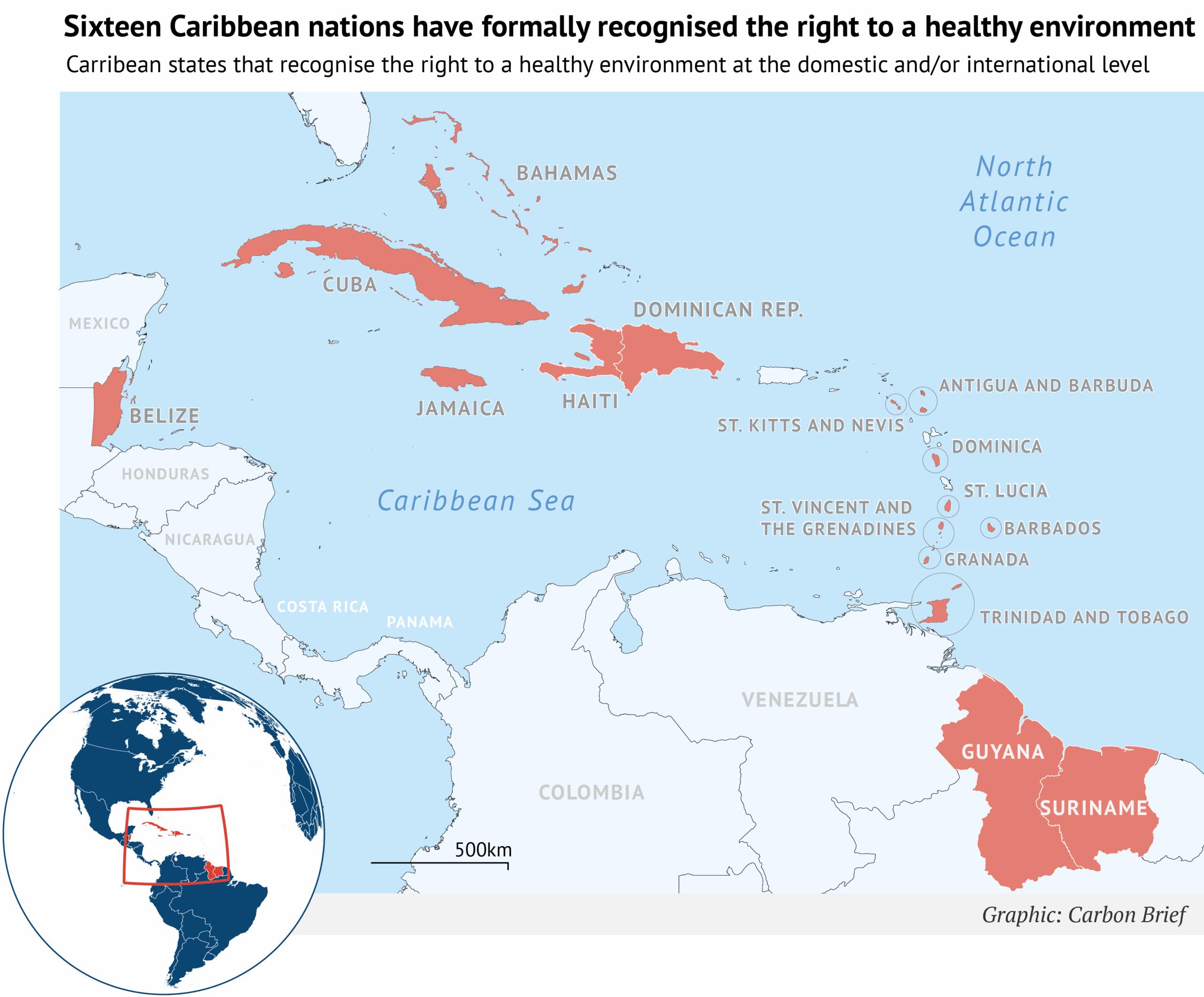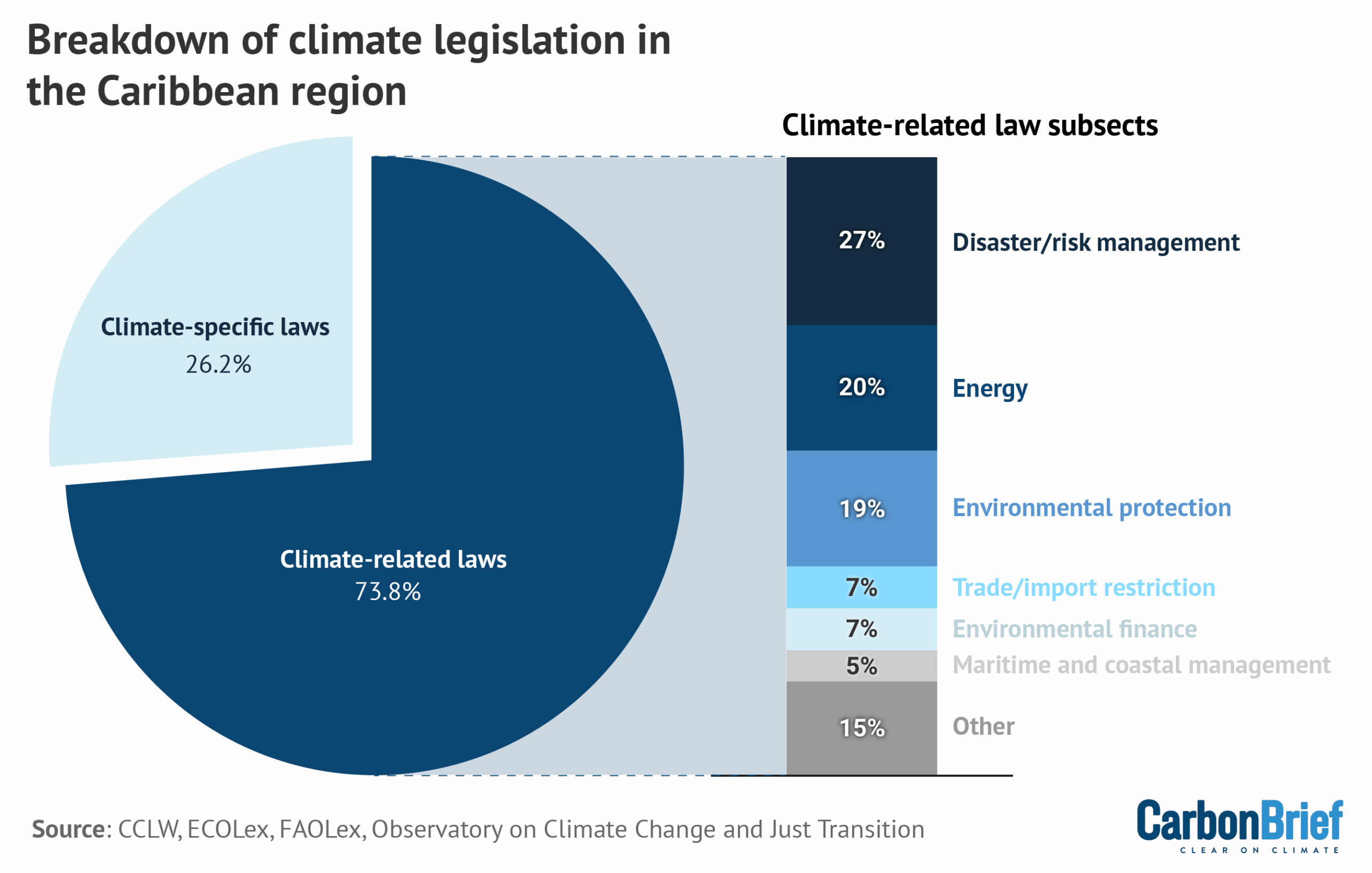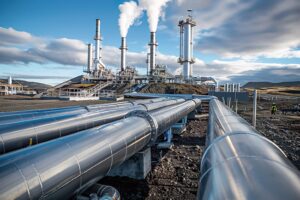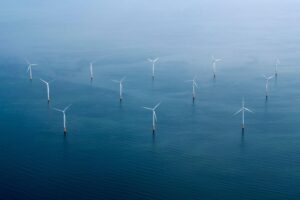China’s carbon dioxide (CO2) emissions stayed at, or just below, last year’s levels in the third quarter of 2024, after a fall in the second quarter.
The new analysis for Carbon Brief, based on official figures and commercial data, leaves open the possibility that China’s emissions could fall this year.
However, recent record-high temperatures caused emissions to go up in September and new government stimulus measures mean there is now greater uncertainty over the country’s emissions trajectory.
Heatwaves through much of August and September caused a major increase in electricity demand for air conditioning, which, combined with weak hydropower output, meant a 2% increase in coal-fired power generation and a 13% rise for gas-fired power in the third quarter, despite wind and solar growth continuing to break records.
The increase in emissions in the power sector was offset by falling emissions from steel, cement and oil use, plus stagnating gas demand outside the power sector, meaning China’s CO2 output in the third quarter was flat or slightly declined, relative to a year earlier.
Other key findings from the analysis include:
- Solar generation rose 44% in the third quarter of the year and wind by 24%, with both continuing to see record-breaking additions of new capacity.
- Hydro generation was up 11% compared with last year’s drought-affected figures, but remained short of expected output. Nuclear power was up 4%.
- Oil demand fell by around 2%, due to falling construction activity, the rise of electric vehicles (EVs) and natural gas (LNG) trucks, as well as weak consumer spending.
- Emissions from steel fell by 3% and cement by 12% in the third quarter, as both sectors continued to see the effect of falling construction activity.
- The coal-to-chemicals industry received renewed political backing and coal consumption in the sector has risen by nearly a fifth in the year to date.
Emissions would need to fall by at least 2% in the last three months of the year, for China’s annual total to drop from 2023 levels. This outcome is supported by the ongoing slowdown in industrial power demand growth and the end of the air-conditioning season.
However, new economic stimulus plans announced in late September with no apparent emphasis on emissions, add uncertainty to this outlook.
In any case, China will remain off track against its 2025 “carbon intensity” target, which requires emissions cuts of at least 2% in 2024 and 2025, after rapid rises in 2020-23.
Looking further ahead, policymakers recently provided new indications of the country’s plans for peaking and reducing emissions, signalling a gradual and cautious approach which falls short of what would be needed to align with the goals of the Paris Agreement.
But, if the country’s rapid clean energy growth is sustained, it has the potential to deliver emission reductions more swiftly.
Clean-energy expansion met all power-demand growth over summer
Defying predictions of slowing growth, China’s electricity demand increased by 7.2% year-on-year in the third quarter of 2024, up from an already rapid 6.9% in the second quarter.
The make-up of growth changed, however. Some 60% of the increase in demand came from the residential and services sectors, with household demand up by a blistering 15%.
Industrial power-demand growth continued to slow down, increasing by 4.6% in July–September, down from 5.9% in the second quarter.
At the same time, solar power generation increased by 44% year-on-year and wind power generation by 24%. Hydropower grew 11%, despite falling short of average utilisation, and nuclear power generation growth was muted at 4% due to few new reactors being commissioned.
The rapid rise of electricity demand outpaced these increases from low-carbon sources, with the gap between demand and rising clean supply being met by a 2% increase in coal-fired power generation and a 13% rise for gas-fired power, as shown in the figure below.
This caused a 3% increase in CO2 emissions from the sector in the third quarter of the year.

However, looking at the whole summer period, whether taken as May-September or June-August, clean-energy expansion covered all of electricity demand growth.
This year, August and September were hotter than last year, resulting in rapid growth in power demand for air conditioning. Last year, in contrast, June and July were hotter.
Thermal power generation from coal and gas fell overall during the summer period, despite the rapid increase in residential power demand, with a 7% drop in June, 5% drop in July, a 4% increase in August and a 9% increase in September. Growth rates during individual months are heavily affected by which months the worst heatwaves fall on.
In terms of newly built generating capacity, solar continued to break last year’s records, with 163 gigawatts (GW) added in the first nine months of 2024. This is equal to the combined total capacity in Germany, Spain, Italy and France, the four EU countries with the most solar capacity. China’s solar capacity additions in the third quarter were up 22% year-on-year, as shown in the figure below.

The growth in China’s solar power output this year alone is likely to equal the total power generation of Australia or Vietnam in 2023, based on growth rates during the first nine months of the year.
Wind power additions accelerated as well, with 38GW added in the year to September, up 10% year-on-year and exceeding the total wind power capacity in the UK of 30GW.
China’s State Council approved 11 new nuclear reactors for construction in one go in August. The total power generating capacity of the approved projects is about 13GW. With 10 reactors approved in both 2022 and 2023 – and now 11 in 2024 – the next batch of nuclear power capacity is getting off the ground and adding to China’s clean-energy growth.
Hydropower capacity only increased 2% year-on-year, implying that most of the 11% third-quarter increase in generation was due to a recovery in capacity utilisation.
In response to severe droughts, utilisation had fallen to its lowest level in more than a decade in 2022, and recovered only partially in 2023, so this year’s recovery was expected and is closer to expected average hydropower generation.
China’s approvals of new coal power plant projects plummeted by 80% in the first half of 2024. Just 9GW of new capacity was approved, down from 52GW in the first half of last year. However, according to the Polaris Network, an energy sector news and data provider, eight large coal power projects were approved in the third quarter, likely representing an uptick in the rate of approvals compared with the first half of the year.
Construction and oil demand slowdown continued to pull down total emissions
While power sector emissions saw a small amount of growth in the third quarter of 2024, the ongoing contraction in construction volumes pulled down total emissions.
As a result, CO2 emissions stayed flat in the third quarter of 2024, at or just below the levels seen in the same period a year earlier, as shown in the figure below.

Digging deeper into the construction-led decline in emissions outside the power sector, steel output fell 9% and cement 12%, as real estate investment contracted 10% in the third quarter, maintaining the same rate as in the first half-year.
This translated into an 11% (24m tonnes of CO2, MtCO2) reduction in CO2 emissions from cement compared with the same period in 2023, shown in the figure below.
Steel emissions only fell by 3% (13MtCO2), despite the 9% fall in steel production. The reason is that the brunt of the drop in demand was borne by electric arc steelmakers rather than the coal-based steel plants with a much higher emission intensity.
The sector lacks the incentive to prioritise electric arc furnaces, which use recycled scrap and have much lower emissions. In theory, this could be encouraged by the inclusion of steel in China’s emissions trading system.
However, if the sector is treated in the same way as power, with separate benchmarks for coal-based and electric steelmaking, it will not create incentives to switch to electricity.
As one step towards structural change in the sector, the industry ministry issued a policy suspending all permitting of new steelmaking capacity, turning a de-facto stop to new permits – observed since the beginning of the year – into a formal moratorium. Until last year, the sector had been investing heavily in new coal-based steel capacity.

The other major area where emissions fell is oil consumption, which saw a 2% (13MtCO2) reduction in oil-related CO2 emissions in the third quarter of the year, also shown in the figure above. This is based on numbers from the National Bureau of Statistics.
The reduction in oil demand and related CO2 emissions may have been even steeper. The supply of oil products, measured as refinery throughput net of imports and exports, fell much more sharply. Based on this measure, CO2 from burning oil fell 10% (63MtCO2) in the third quarter, meaning that China’s CO2 emissions overall would have fallen by 2%.
The much more modest drop reported by the statistics agency could reflect the tendency of China’s statistical reporting to smooth downturns and upticks.
Another possible explanation is that refineries had previously been producing more than was being consumed, and have now had to cut output to reduce inventories.
Regardless of the magnitude of the drop, it is possible to identify the drivers of falling oil consumption. The fall in construction volumes is a major factor, as a significant share of diesel is used at construction sites and for transporting building materials.
The increase in the share of EVs is eating into petrol demand. Demand was also driven down by household spending, which remained weak until picking up in October in response to expectations of government stimulus.
The increasing share of trucks running on LNG also contributed to the fall in diesel demand. LNG truck sales accounted for about 20% of total truck sales in the nine months to March 2024, but weak overall gas demand growth indicates that this had a limited impact.
Gas consumption growth slowed down to 3% in the third quarter, from 10% in the first half of the year. Growth took place entirely in the power sector, with demand from other sectors stagnating, likely due to weak industrial demand.
After an increase in emissions in January-February, falling emissions in March-August and an increase in September, emissions would need to fall by at least 2% in the last three months of the year, for China’s annual total to drop from 2023 levels.
There is a good chance this will happen, due to an ongoing slowdown in industrial power demand growth and the end of the air conditioning season. But, even then, China would remain off track against its 2025 carbon intensity target, which requires emissions to fall by at least 2% in both 2024 and 2025, after rapid increases from 2020 to 2023.
The fundamental reason why emissions have not fallen faster – and may not have fallen at all in the third quarter – is that energy consumption growth this year continues to be much faster than historical trends.
Total energy consumption – including, but not limited to electricity consumption – grew 5.0% in the third quarter, faster than GDP, which gained 4.6%.
Until the Covid-19 pandemic, China’s energy demand growth had been much slower than GDP growth, implying falling energy intensity of the economy.
The post-Covid economic policy focused on manufacturing appears to have reversed this trend.
Coal-to-chemicals industry received new political backing
One additional wildcard in the outlook for China’s CO2 emissions is the coal-to-chemicals industry. The sector turns domestic coal into replacements for imported oil and gas, albeit with a far higher carbon footprint.
A recent policy from the National Development and Reform Commission, China’s powerful planning agency, called for ”accelerating” the development of the coal-to-chemical industry, including “speeding up the construction of strategic bases for coal-to-oil and coal-to-gas production”.
The past weeks after the issuance of the new policy have seen construction starts of a major coal-to-oil project in Shanxi, a coal-to-chemicals park in Sha’anxi and approval of a similar project in Xinjiang.
The coal-to-chemicals industry is expected to use more than 7% of all coal consumed in China in 2024, according to China Futures Research, a consultancy.
Coal consumption by the chemicals industry increased 18% in the first eight months of 2024, after a 9% increase in 2023, based on data from Wind Financial Terminal. This increase in coal consumption for coal-to-chemicals contributed two thirds of the 0.9% increase in total fossil CO2 emissions during the January to August period.
Coal consumption growth in the sector slowed down to 5% in July-August, however, and output of chemical products continued to slow in September. This smaller contribution to growth in CO2 emissions is shown in the graph above (“chemical industry”).
The recent rise in oil and gas prices, together with efforts to increase China’s domestic coal production and drive down domestic coal prices, have provided a major boost to the coal chemicals sector, which has a high sensitivity to both oil and coal prices.
Coal-to-chemicals is the sector where China’s policy priorities of energy security and emission reductions are most directly at odds.
Economic stimulus adds uncertainty to emissions outlook
After economic data indicated continuing slowdown and shortfall against GDP growth targets over the summer, expectations of a stimulus package built up.
The government responded in late September with a set of announcements, pledging various stimulus measures. The measures were focused on financial markets, but also included a commitment to “stabilise” the housing market.
The size of the stimulus package is not very large by China’s standards, and further details have disappointed those who hoped for a more radical policy turnaround. Yet, the package is clearly thought-through and coordinated, offering insights into how China’s top policymakers are planning to address the economic headwinds.
Direct income transfers of government money to households, which have been a hot topic for the past couple of years, are now going to be tried out.
Efforts to boost household spending, instead of the energy-intensive manufacturing and construction that has been the focus of previous rounds of government stimulus, would enable China to grow in a much less energy- and carbon-intensive way.
However, the sums allocated to income transfers are very small in relation to the size of the whole package. Much more money will be spent on subsidies to car and white-goods purchases. This will free up household cash for other types of spending, but it also directs household spending in the most energy-intensive direction.
Most of the stimulus is directed through the traditional routes of local government borrowing and bank lending, which tend to go into industrial and infrastructure projects.
There is no explicit climate-related emphasis to this stimulus. Quite a bit of it is likely to flow to clean energy-related investments, simply because those have been so dominant in China’s investment flows recently, but there is no further push in that direction.
Policymakers do not see an ‘early’ peak
While the rapid clean-energy growth points to the possibility of China’s emissions peaking imminently, policymakers are still setting an expectation that emissions will increase until the end of the decade and plateau or fall very gradually thereafter.
In August, China’s National Energy Administration played down the possibility of the country’s emissions having already peaked, in response to a question from a reporter referencing analyses suggesting this was possible.
The NEA department head who responded to the question emphasised that the timeline for peaking the country’s emissions – “before 2030” – has already been set by the top leadership, implying that the NEA has no mandate to change it.
The Central Committee of the Communist Party – one of the country’s highest leadership groups – reaffirmed that the aim is to “establish a falling trend” in emissions by 2035.
An earlier State Council plan said that China would focus on controlling total CO2 emissions, rather than emissions intensity, after the emission peak has been reached, and indicated that this would not happen in the 2026-30 period.
A very gradual approach to peaking emissions and reducing them after the peak, leaving more substantial emission reductions to later decades, is permissible under China’s current commitments under the Paris Agreement.
However, such a pathway would see the country use up 90% of the global emission budget for 1.5C. In scenarios that limit warming to 1.5C, China’s emissions are cut to at least 30% below 2023 levels by 2035. And recent International Energy Agency (IEA) analysis found that emerging markets such as China would need to cut emissions to 35-65% below 2022 levels by 2035, to align with the global pledges made at COP28 or national net-zero targets.
In contrast with the cautious approach telegraphed by Chinese policymakers, maintaining the rate of clean energy additions and electrification achieved in recent years could deliver a 30% reduction in CO2 emissions from fossil fuels by 2035, relative to 2023 levels.
Similarly, the IEA’s latest World Energy Outlook found clean-energy growth would help cut China’s CO2 emissions to 24% below 2023 levels by 2035, based on current policy settings. This reduction would increase to 45% by 2035 if China met its announced ambitions and targets, the IEA said.
China’s upcoming nationally determined contribution (NDC), due to be submitted to the UN under the Paris Agreement by February 2025, is expected to provide more clarity on which emissions pathway the policymakers are pursuing.
About the data
Data for the analysis was compiled from the National Bureau of Statistics of China, National Energy Administration of China, China Electricity Council and China Customs official data releases, and from WIND Information, an industry data provider.
Wind and solar output, and thermal power breakdown by fuel, was calculated by multiplying power generating capacity at the end of each month by monthly utilisation, using data reported by China Electricity Council through Wind Financial Terminal.
Total generation from thermal power and generation from hydropower and nuclear power was taken from National Bureau of Statistics monthly releases.
Monthly utilisation data was not available for biomass, so the annual average of 52% for 2023 was applied. Power sector coal consumption was estimated based on power generation from coal and the average heat rate of coal-fired power plants during each month, to avoid the issue with official coal consumption numbers affecting recent data.
When data was available from multiple sources, different sources were cross-referenced and official sources used when possible, adjusting total consumption to match the consumption growth and changes in the energy mix reported by the National Bureau of Statistics for the first quarter, the first half and the first three quarters of the year. The effect of the adjustments is less than 1% for total emissions, with unadjusted numbers showing a 1% reduction in emissions in the third quarter.
CO2 emissions estimates are based on National Bureau of Statistics default calorific values of fuels and emissions factors from China’s latest national greenhouse gas emissions inventory, for the year 2018. Cement CO2 emissions factor is based on annual estimates up to 2023.
For oil consumption, apparent consumption is calculated from refinery throughput, with net exports of oil products subtracted.
The post Analysis: No growth for China’s emissions in Q3 2024 despite coal-power rebound appeared first on Carbon Brief.
Analysis: No growth for China’s emissions in Q3 2024 despite coal-power rebound
Greenhouse Gases
DeBriefed 10 October 2025: Renewables power past coal; Legacy of UK’s Climate Change Act; Fukushima’s solar future
Welcome to Carbon Brief’s DeBriefed.
An essential guide to the week’s key developments relating to climate change.
This week
Renewables overtake coal
‘HISTORIC FIRST’: Renewables have overtaken coal to become the world’s leading source of electricity for the first six months of this year in a “historic first”, BBC News said. The analysis, from the thinktank Ember, found the world generated “almost a third” more solar power in the first half of the year, compared with the same period in 2024, while wind power grew by “just over 7%,” reported the Guardian.
HEAVY LIFTING: According to the report, China and India were “largely responsible for the surge in renewables”, while the US and Europe “relied more heavily on fossil fuels,” the Guardian wrote. China built more renewables than every other country combined in the first half of this year, the newspaper added.
CONTINENTAL SHIFTS: A second report from the International Energy Agency (IEA) predicted a “surge” in global wind and solar capacity by 2030, but shaved 5% off its previous forecast, the Financial Times said. The IEA revealed that India is set to become the second-largest growth market for renewables after China, “with capacity expected to increase 2.5 times by 2030”, Down to Earth reported. The IEA also upped its forecast for renewables in the Middle East and north Africa by 23%, “helped by Saudi Arabia rolling out wind turbines and solar panels”, but halved the outlook for the US, the FT noted.
Around the world
- EV BOOM: Sales of electric and hybrid cars made up “more than half” of all new car registrations in the UK last month, a new record, according to data from the Society of Motor Manufacturers, reported BBC News.
- BANKING COLLAPSE: A global banking alliance launched by the UN to get banks to slash the carbon footprint of their loans and investments and help drive the transition to a net-zero economy by 2050 has collapsed after four years, Agence France-Press reported.
- CUTS, CUTS, CUTS: The Trump administration plans to cut nearly $24bn in funding for more than 600 climate projects across the US, according to documents reviewed by the Wall Street Journal.
- PEOPLE POWER: A farmer, a prison guard and a teacher were among those from the Dutch-Caribbean island Bonaire who appeared at the Hague on Tuesday to “accuse the Netherlands of not doing enough to protect them from the effects of climate change”, Politico reported.
400,000
The number of annual service days logged by the US National Guard responding to hurricanes, wildfires and other natural disasters over the past decade, according to a Pentagon report to Congress, Inside Climate News reported.
Latest climate research
- Politicians in the UK “overwhelmingly overestimate the time period humanity has left to bend the temperature curve”, according to a survey of 100 MPs | Nature Communications Earth and Environment
- Fire-driven degradation of the Amazon last year released nearly 800m tonnes of CO2 equivalent, surpassing emissions from deforestation and marking the “worst Amazon forest disturbance in over two decades” | Biogeosciences
- Some 43% of the 200 most damaging wildfires recorded over 1980-2023 occurred in the last decade | Science
(For more, see Carbon Brief’s in-depth daily summaries of the top climate news stories on Monday, Tuesday, Wednesday, Thursday and Friday.)
Captured

The UK’s Climate Change Act, landmark legislation that guides the nation’s response to climate change, is increasingly coming under attack from anti-net-zero right-leaning politicians. In a factcheck published this week, Carbon Brief explained how the UK’s Climate Change Act was among the first comprehensive national climate laws in the world and the first to include legally binding emissions targets. In total, 69 countries have now passed “framework” climate laws similar to the UK’s Climate Change Act, with laws in New Zealand, Canada and Nigeria among those explicitly based on the UK model. This is up from just four when the act was legislated in 2008. Of these, 14 are explicitly titled the “Climate Change Act”.
Spotlight
Fukushima’s solar future
This week, Carbon Brief examines how Fukushima helped to recover from nuclear disaster by building solar farms on contaminated farmland.
On 11 March 2011, an earthquake off the pacific coast of Japan caused 15m-tall waves to crash into the eastern region of Tōhoku, killing 19,500 people and injuring a further 6,000.
In the aftermath, flooding at the Fukushima Daichi nuclear power plant caused cooling systems to fail, leaching radioactive contaminants into the soil and leading to a major nuclear incident.
Some 1,200km2 around the site was restricted and up to 100,000 people were evacuated – in some cases forever.
In the years following, Japan entered a fraught debate about nuclear energy.
In 2010, nuclear power provided 25% of Japan’s electricity, but, in the years following the disaster, its 54 nuclear reactors were taken offline.
Successive governments have fought over reintroducing nuclear power. Today, some 14 reactors are back online, 27 have been permanently closed and another 19 remain suspended. (Japan’s newly-elected prime minister Sanae Takaichi has promised to make nuclear central to her energy strategy.)
Against this backdrop, Fukushima – a prefecture home to 1.8 million people – has emerged as a surprise leader in the renewables race.
In 2014, the Fukushima Renewable Energy Institute (FREA) opened with the twin goals of promoting research and development into renewable energy, while “making a contribution to industrial clusters and reconstruction”.
That same year, the prefecture declared a target of 100% renewable power by 2040.
Contaminated land
“A lot of these communities, I know, were looking for ways to revitalise their economy,” said Dr Jennifer Sklarew, assistant professor of energy and sustainability at George Mason University and author of “Building Resilient Energy Systems: Lessons from Japan”.
Once evacuation orders were lifted, however, residents in many parts of Fukushima were faced with a dilemma, explained Skarlew:
“Since that area was largely agricultural, and the agriculture was facing challenges due to stigma, and also due to the soil being removed [as part of the decontamination efforts], they had to find something else.”
One solution came in the form of rent, paid to farmers by companies, to use their land as solar farms.
Michiyo Miyamoto, energy finance specialist at the Institute for Energy Economics and Financial Analysis, told Carbon Brief:
“The [Fukushima] prefecture mapped suitable sites early and conducted systematic consultations with residents and agricultural groups before projects were proposed. This upfront process reduced land-use conflicts, shortened permitting timelines and gave developers clarity.”
As a result, large-scale solar capacity in Fukushima increased to more than 1,300 megawatts (MW) from 2012 to 2023, according to Miyamoto. Moreover, installed renewable capacity now exceeds local demand, meaning the region can run entirely on clean power when conditions are favourable, Miyamoto said.
Today, aerial pictures of Fukushima reveal how solar panels have proliferated on farmland that was contaminated in the nuclear disaster.

Charging on
Last year, 60% of Fukushima’s electricity was met by renewables, up from 22% in 2011. (The country as a whole still lags behind at 27%.)
And that is set to grow after Japan’s largest onshore windfarm started operations earlier this year in Abukuma, Fukushima, with a capacity of 147MW.
The growth of solar and wind means that Fukushima is already “ahead of schedule” for its 2040 target of 100% renewable power, said Miyamoto:
“The result is a credible pathway from recovery to leadership, with policy, infrastructure and targets working in concert.”
Watch, read, listen
OVERSHOOT: The Strategic Climate Risks Initiative, in partnership with Planet B Productions, has released a four-part podcast series exploring what will happen if global warming exceeds 1.5C.
DRONE WARFARE: On Substack, veteran climate campaigner and author Bill McKibben considered the resilience of solar power amid modern warfare.
CLIMATE AND EMPIRE: For Black history month, the Energy Revolution podcast looked at how “race and the legacies of empire continue to impact the energy transition”.
Coming up
- 12 October: presidential elections, Cameroon
- 13-14 October: Pre-COP, Brasilia, Brazil
- 13-18 October: World Bank Group/IMF annual meetings, Washington DC
- 14-17 October: 2nd extraordinary session of the Marine Environment Protection Committee at the International Maritime Organisation, London
- 15-16 October: Circle of Finance Ministers report
Pick of the jobs
- Buckinghamshire Council, principal climate change officer | Salary: £49,354-£51,759. Location: Aylesbury, Buckinghamshire
- Sustainable NI, sustainable business lead | Salary: £60,000. Location: Belfast, Northern Ireland
- Dialogue Earth, South Asia managing editor | Salary: £1,875 per month. Location: South Asia
DeBriefed is edited by Daisy Dunne. Please send any tips or feedback to debriefed@carbonbrief.org.
This is an online version of Carbon Brief’s weekly DeBriefed email newsletter. Subscribe for free here.
The post DeBriefed 10 October 2025: Renewables power past coal; Legacy of UK’s Climate Change Act; Fukushima’s solar future appeared first on Carbon Brief.
Greenhouse Gases
Guest post: How Caribbean states are shifting climate legislation
The Caribbean region is among the most vulnerable to climate change, despite historically contributing less than half of one percent of global greenhouse gas emissions.
Rising sea levels, extreme heat and more frequent and intense storms – such as the 2024 Hurricane Beryl, which made landfall in Grenada – pose urgent and growing threats to the small island states, coastal nations and overseas territories that comprise the Caribbean region.
With global progress to address climate change still too slow, Caribbean countries are taking matters into their own hands by enacting more robust legislation to help protect against climate risks.
In a new study published in the Carbon and Climate Law Review, we identified 78 climate laws and legally binding decrees across 16 Caribbean states, as well as two constitutional references to climate change and a growing recognition of the right to a healthy environment.
Our analysis suggests that, together, these developments are not only enhancing resilience, but also positioning Caribbean states as influential actors in the global climate arena.
Caribbean climate laws on the rise
Climate governance in the Caribbean has expanded significantly in recent years. In the past decade, countries such as Cuba and the Dominican Republic have embedded climate obligations and programmatic guidelines into their national constitutions.
At the same time, legislative recognition of the human right to a healthy environment is gaining momentum across the region. Six Caribbean nations now affirm the right in their constitutions, while 15 have recognised it through international instruments, such as the UN Council, UN Assembly and the Escazu Agreement, as shown in the figure below.

More recently, there has been a notable rise in targeted, sector-specific climate frameworks that go beyond broader environmental statutes.
Saint Lucia stands out as the only country with a climate framework law, or a comprehensive national law that outlines long-term climate strategies across multiple domains. Meanwhile, several other Caribbean governments have adopted climate-specific laws that focus on individual sectors, such as energy, migration and disaster management.
According to our analysis, more than a quarter of climate-relevant legislation in the region – comprising 21 laws and legally binding decrees – now has an explicit focus on climate change, as illustrated in the chart below.
Our research suggests that this represents an ongoing shift in legislative focus, reflecting changes in how climate legislation is being structured in one of the world’s most climate-vulnerable regions.

Caribbean nations are also advancing legal reforms to structure and institutionalise climate finance and market mechanisms directly into domestic law, aligned with Article 6.2 of the Paris Agreement.
For example, the Bahamas has introduced provisions for carbon credit trading, while Antigua and Barbuda, Barbados and Grenada have established national climate financing mechanisms to support mitigation and adaptation efforts.
Some states, including Belize and Saint Kitts and Nevis, have incorporated regional bodies such as the Caribbean Community Climate Change Centre – the climate arm of the intergovernmental Caribbean community organisation CARICOM – into national frameworks. This indicates an increasing alignment between regional cooperation and domestic law.
In addition to the influx of regulations specifically addressing climate change, Caribbean nations are also legislating broader environmental issues, which, in turn, could provide increased resilience from climate impacts and risks, as shown in the graph above.
Key trends in these types of climate-related laws include the expansion of disaster risk management governance, which addresses national preparedness for climate-induced weather events or related catastrophes. Likewise, energy law is an increasingly prominent focus, with countries including Antigua and Barbuda and Saint Vincent and the Grenadines integrating renewable energy and energy efficiency goals into national climate governance.
More broadly, many Caribbean nations have adopted wide-ranging and comprehensive environmental laws, many of which were developed in alignment with existing climate commitments. In combination, these legal developments reflect a dynamic and evolving climate governance landscape across the region.
Proactive vs reactive approaches
Despite general alignment with these broader regional trends, our research reveals distinct developmental pathways shaping domestic climate regulation.
In the eastern Caribbean, for example, we saw both proactive, long-term planning strategies and reactive, post-disaster reforms.
Saint Lucia’s multifaceted approach to climate resilience evolved steadily over the course of more than a decade. During this time, the country developed numerous adaptation plans, strengthened cross-sectoral coordination and engaged in institutional climate reforms in areas such as energy, tourism, finance and development.
More recently, the passage of Saint Lucia’s Climate Change Act in 2024 marked a milestone in climate governance, by giving legal force to the country’s obligations under the UNFCCC, the Kyoto Protocol and the Paris Agreement – making Saint Lucia one of the few small island states to incorporate global climate commitments into domestic law.
Our research indicates that this strategy has not only positioned the country as a more climate-resilient nation, but also solidified its access to international climate financing.
In contrast, Dominica’s efforts evolved more rapidly in the aftermath of Hurricane Maria in 2017, which destroyed over 200% of the country’s GDP. The storm’s impacts were felt across the country and hit particularly hard for the Kalinago people – the Caribbean’s last Indigenous community – highlighting the role of socioeconomic disparities in shaping climate vulnerability and resilience.
In response, the government passed the Climate Resilience Act, creating the temporary Climate Resilience Execution Agency for Dominica (CREAD).
Beyond establishing an exclusively climate-focused institution, the act aimed to embed resilience into governance by mandating the participation of vulnerable communities – including Indigenous peoples, women, older people and people with disabilities – in shaping and monitoring climate resilience projects.

As noted in a recent statement by the UN special rapporteur on Climate Change, Dr Elisa Morgera, these frameworks underscore the government’s ambition to become the world’s first “climate-resilient nation.”
Although challenges persist, Dominica’s efforts demonstrate how post-disaster urgency can drive institutional change, including the integration of rights and resilience into climate governance.
Uneven progress and structural gaps
Despite significant progress, our research shows that several key opportunities for climate governance across the Caribbean continue to exist, which could enable improvements in both resilience and long-term ambition.
The region’s legal landscape remains somewhat heterogeneous. While Saint Lucia has enacted a comprehensive climate framework law, the rest of the region lacks similar blanket legislation. This includes some states that entirely lack climate-specific laws, instead relying on related laws and frameworks to regulate and respond to climate-related risks.
Other nations have yet to adopt explicit disaster-risk management frameworks, leaving Caribbean populations vulnerable before, during and after climate emergencies. Most have yet to enshrine the right to a healthy environment at the national level.
Our research suggests that outdated legal frameworks are further limiting progress in addressing current climate risks. Because many of the longer-standing environmental laws in the region were adopted well before climate policy became a mainstream concern, some fail to address the nature, frequency and intensity of modern climate challenges, such as sea-level rise, tropical storms, wildfires, floods, droughts and other impacts.
More broadly, many Caribbean climate laws include limited integration of gender equity, Indigenous rights and social justice. As Caribbean nations such as Grenada and the Dominican Republic begin to link climate resilience with these issues, the region has an opportunity to lead by example.
Ultimately, capacity and resource constraints persist as significant barriers to implementation and adaptation.
The Caribbean region faces debt that exacerbates ongoing development challenges, a burden made heavier by the repeated economic shocks of climate-related disasters. Along with regional debt-for-resilience schemes, increased funding from high-emitting countries to support adaptation measures in climate-vulnerable nations – as endorsed under the Paris Agreement – is likely to be critical to ensuring the region’s climate laws can be executed effectively.
Global implications of Caribbean climate law
Our research suggests that Caribbean countries are outpacing other regions in terms of the scope and ambition of their climate laws. This legislation has the potential to serve as a model for climate-vulnerable nations worldwide.
Continuing efforts in the region show that legal frameworks in the field can not only drive resilience, embed rights and strengthen claims to international finance, but also highlight how regional cooperation and diplomacy can enhance global influence.
These findings demonstrate that innovation in climate law need not wait for action from major emitters, but can instead be led by those on the front lines of climate change.
The post Guest post: How Caribbean states are shifting climate legislation appeared first on Carbon Brief.
Guest post: How Caribbean states are shifting climate legislation
Greenhouse Gases
IEA: Renewables have cut fossil-fuel imports for more than 100 countries
More than 100 countries have cut their dependence on fossil-fuel imports and saved hundreds of billions of dollars by continuing to invest in renewables, according to the International Energy Agency (IEA).
It says nations such as the UK, Germany and Chile have reduced their need for imported coal and gas by around a third since 2010, mainly by building wind and solar power.
Denmark has cut its reliance on fossil-fuel imports by nearly half over the same period.
Renewable expansion allowed these nations to collectively avoid importing 700m tonnes of coal and 400bn cubic metres of gas in 2023, equivalent to around 10% of global consumption.
In doing so, the fuel-importing countries saved more than $1.3tn between 2010 and 2023 that would otherwise have been spent on fossil fuels from overseas.
Reduced reliance
The IEA’s Renewables 2025 report quantifies the benefits of renewable-energy deployment for electricity systems in fossil fuel-importing nations.
It compares recent trends in renewable expansion to an alternative “low renewable-energy source” scenario, in which this growth did not take place.
In this counterfactual, fuel-importing countries stopped building wind, solar and other non-hydropower renewable-energy projects after 2010.
In reality, the world added around 2,500 gigawatts (GW) of such projects between 2010 and 2023, according to the IEA, more than the combined electricity generating capacity of the EU and US in 2023, from all sources. Roughly 80% of this new renewable capacity was built in nations that rely on coal and gas imports to generate electricity.
The chart below shows how 31 of these countries have substantially cut their dependence on imported fossil fuels over the 13-year period, as a result of expanding their wind, solar and other renewable energy supplies. All of these countries are net importers of coal and gas.

In total, the IEA identified 107 countries that had reduced their dependence on fossil fuel imports for electricity generation, to some extent due to the deployment of renewables other than hydropower.
Of these, 38 had cut their reliance on electricity from imported coal and gas by more than 10 percentage points and eight had seen that share drop by more than 30 percentage points.
Security and resilience
The IEA stresses that renewables “inherently strengthen energy supply security”, because they generate electricity domestically, while also “improving…economic resilience” in fossil-fuel importer countries.
This is particularly true for countries with low or dwindling domestic energy resources.
The agency cites the energy crisis exacerbated by Russia’s invasion of Ukraine, which exposed EU importers to spiralling fossil-fuel prices.
Bulgaria, Romania and Finland – which have historically depended on Russian gas for electricity generation – have all brought their import reliance close to zero in recent years by building renewables.
In the UK, where there has been mounting opposition to renewables from right-wing political parties, the IEA says reliance on electricity generated with imported fossil fuels has dropped from 45% to under 25% in a decade, thanks primarily to the growth of wind and solar power.
Without these technologies, the UK would now be needing to import fossil fuels to supply nearly 60% of its electricity, the IEA says.
Other major economies, notably China and the EU, would also have had to rely on a growing share of coal and gas from overseas, if they had not expanded renewables.
As well as increasing the need for fossil-fuel imports from other countries, switching renewables for fossil fuels would require significantly higher energy usage “due to [fossil fuels’] lower conversion efficiencies”, the IEA notes. Each gigawatt-hour (GWh) of renewable power produced has avoided the need for 2-3GWh of fossil fuels, it explains.
Finally, the IEA points out that spending on renewables rather than imported fossil fuels keeps more investment in domestic economies and supports local jobs.
The post IEA: Renewables have cut fossil-fuel imports for more than 100 countries appeared first on Carbon Brief.
IEA: Renewables have cut fossil-fuel imports for more than 100 countries
-
Climate Change2 years ago
Spanish-language misinformation on renewable energy spreads online, report shows
-
Climate Change2 months ago
Guest post: Why China is still building new coal – and when it might stop
-
Climate Change Videos2 years ago
The toxic gas flares fuelling Nigeria’s climate change – BBC News
-

 Greenhouse Gases1 year ago
Greenhouse Gases1 year ago嘉宾来稿:满足中国增长的用电需求 光伏加储能“比新建煤电更实惠”
-
Greenhouse Gases2 months ago
Guest post: Why China is still building new coal – and when it might stop
-

 Climate Change1 year ago
Climate Change1 year ago嘉宾来稿:满足中国增长的用电需求 光伏加储能“比新建煤电更实惠”
-

 Carbon Footprint2 years ago
Carbon Footprint2 years agoUS SEC’s Climate Disclosure Rules Spur Renewed Interest in Carbon Credits
-
Renewable Energy3 months ago
US Grid Strain, Possible Allete Sale














